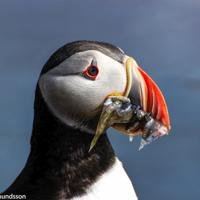
In Iceland, you can see not only active volcanoes, bubbling geysers, and breathtaking glaciers but also some special species of animals. One of these is the puffin, called Lundi in Icelandic. In most parts of the world, these small birds are rarely seen, but in Iceland, you have a good chance to meet a whole colony in summer. Of the approximately 12 million birds worldwide, about 60% of the world's population live on or around the Arctic island.
Around mid to late April, the birds return from their winter domicile and settle on the grass-covered upper areas of Iceland's cliffs. As they do so, each pair returns to the same den they inhabit each year. Visitors then have the opportunity to observe the cute birds until mid-August at the latest, although it should be noted that many of the observation sites are closed during the breeding season from May to June. The best time to see as many puffins as possible is early in the morning or the evening because the birds are usually out at sea fishing during the day.
Profile
Size:10 - 12 inch long, 1 feed, 8 Inch wingspan
Weight: 0,71- 1 pound
Range: North Atlantic coastlines
Migration: Wintering on the open sea in the North Atlantic Ocean
Food: Fish and zooplankton
Life expectancy: about 20 years
Special characteristics: colorful (red, yellow, orange) bill during the breeding season
Enemies: black-backed gulls, foxes, rats
Breeding season
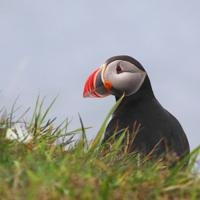
The courtship of puffins begins in April, while they are still out at sea. There they find their mate and fly together with him to the breeding sites, where they either dig a new nest or occupy an already existing nest. The puffins always return to the breeding site where they were born.
Each pair then lays only a single egg, from which the offspring hatch. They stay in the nest for a very long time, about 40 days, until they can fly and start exploring. The fledged birds do not return to the colony after they have flown to the sea. The parents, on the other hand, inhabit the nest for another 3-4 weeks before leaving the breeding grounds, flying to the open sea, and not flying back to land until the next year.
As a rule, these found pairs stay together for the rest of their lives and visit their self-dug burrow every year to hatch the next offspring.
The best places to watch puffins
Note: some observation sites are inaccessible during the breeding season up to and including June
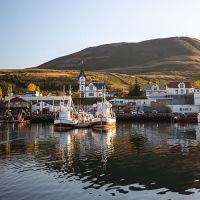
Northern Iceland:
During the breeding season, almost all whale-watching tour operators in Husavik also pass by the nesting island of Lundey on their excursions. Several thousand puffins nest on this small island every year.
Another observation point is located about 40 feet north of the small harbor town at Voldalstorfa at a small orange lighthouse. However, this point can only be reached by a 15-minute hike.
The remote island of Grimsey is only about 2 mi² in size and is Iceland's only part that touches the Arctic Circle. The high bluffs and stunning basalt formations provide breeding grounds for dozens of seabirds. The best time to see the clumsy puffins on Grimsey is between May and June.
East Iceland
In the east of the country lies the harbor of Borgarfördur Eystri and nearby the bird rock Hafnarholmi. This rock is the breeding ground of about 10,000 pairs of puffins annually. A wooden walkway and a viewing platform are only a few meters away from the breeding caves of the birds, so you can experience them almost up close. The rock is a good alternative to Latrabjarg, which is difficult to access.
Note: in May the boardwalk is usually closed to give the birds a rest, so you should check beforehand if the lookout is open.
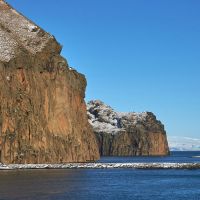 South Iceland:
South Iceland:
The Westman Islands are known for being the largest puffin colony in the world. Every year about 2 million birds return here to hatch their offspring. Especially on the west coast, the small birds can be observed particularly well. When you take the ferry into the harbor of Heimaey, you also have a particularly good view of the breeding burrows of the birds.
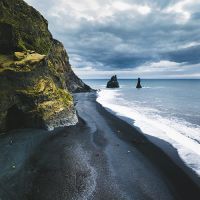
Near the small village of Vík is Cape Dyrholaey, on whose cliffs puffins also breed. Cape Dyrholaey is located directly on the black beach Reynisfjara, from where you have a great view of the sea. You can park the car at the parking lot and follow a small trail to the lighthouse. The road to the rock is closed during the breeding season from May to June.
The bird rock Ingólfshöfdi in southeast Iceland can only be visited during low tide as part of guided tours.
West Iceland:
Látrabjarg is not only the western point of Europe but is also the largest bird rock on the island with its 8,6 mile long cliff. It is located remotely in the Westfjords. Among the many different seabird species that nest at Latrabjarg is the puffin. Other species that breed there are gulls, guillemots, and alcids.
Another very famous observation point in the west of Iceland is Breidafjördur.
These two islands, Akurey and Vides, offer a good opportunity to observe puffins when in Reykjavik. From here there are many guided excursions by boat to the breeding sites on the islands.
Fun Facts
- A group of puffins is also called a colony, circus, or assembly
- Thanks to a unique joint on their beaks, puffins are among the few bird species that can carry several small fish across their beaks
- Puffins can fly up to 56 m/h fast.
- The oldest known puffin was 36 years old
- Scientists can't explain how the puffins find their way back to their breeding hole every year
Attention:
Puffins are not afraid of people. This means that they also often come very close to humans. Nevertheless, a proper distance from the animals should be kept! In addition, the small birds should not be touched for their safety and the safety of observers!
A wide range of puffin excursions can be booked directly with us - just contact us! For more ideas, please have a look at our further selection of excursions. Find inspiration for your next round trip to Iceland here.
